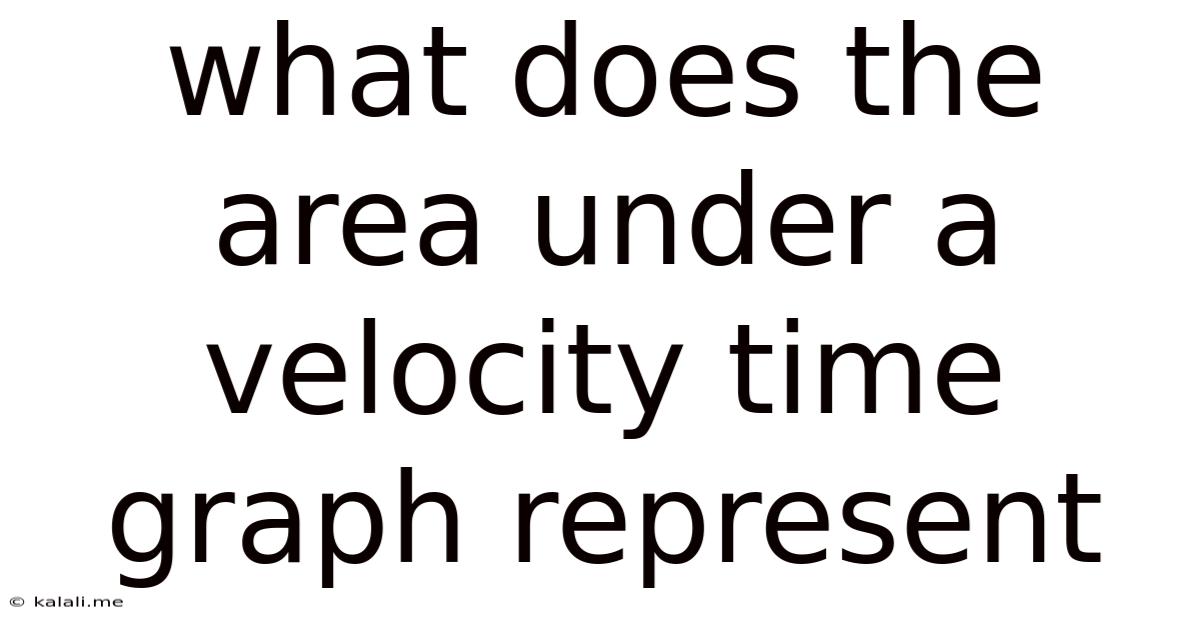What Does The Area Under A Velocity Time Graph Represent
Kalali
Jun 11, 2025 · 3 min read

Table of Contents
What Does the Area Under a Velocity-Time Graph Represent?
The area under a velocity-time graph represents the displacement of an object. This is a fundamental concept in kinematics, the study of motion. Understanding this relationship is crucial for analyzing motion and solving related problems. This article will delve into the reasons why this is true, explore different scenarios, and show you how to practically calculate displacement from a velocity-time graph.
Understanding Velocity and Displacement
Before we dive into the graph, let's clarify the terms:
- Velocity: Velocity is a vector quantity, meaning it has both magnitude (speed) and direction. It describes how quickly an object's position is changing.
- Displacement: Displacement is also a vector quantity. It's the overall change in an object's position from its starting point to its ending point, regardless of the path taken. This is different from distance, which is a scalar quantity (only magnitude) and represents the total length of the path traveled.
Why the Area Represents Displacement
The area under a velocity-time graph represents displacement because of the mathematical relationship between velocity, time, and displacement. Recall the basic equation of motion:
Displacement = Velocity × Time
In a velocity-time graph, the velocity is plotted on the y-axis and the time is plotted on the x-axis. Therefore, each small rectangle within the graph represents a small increment of time multiplied by the average velocity during that time. Summing up the areas of all these tiny rectangles (through integration in calculus, or approximation through geometrical shapes for simpler graphs) gives you the total displacement.
Different Scenarios and Graph Types
The shape of the velocity-time graph will influence how you calculate the area, and consequently, the displacement. Here are a few common scenarios:
1. Constant Velocity
If the velocity is constant, the graph is a straight horizontal line. The area under the graph is simply a rectangle, and the displacement is calculated as:
Displacement = Velocity × Time
This is the simplest case.
2. Constant Acceleration
If the object is accelerating at a constant rate, the graph is a straight line with a non-zero slope. The area under the graph is a trapezoid or a triangle (if the initial velocity is zero). The displacement can be calculated using the area formula for these shapes, or using kinematic equations.
3. Non-Uniform Acceleration
When the acceleration is not constant, the velocity-time graph will be a curve. Calculating the area under the curve requires more advanced mathematical techniques, typically involving integration. Numerical methods can also be used to approximate the area.
4. Velocity Changing Direction
If the velocity changes direction (e.g., the object moves forward, then backward), the velocity becomes negative on the graph. Areas below the x-axis (representing negative velocity) contribute negatively to the total displacement. In essence, you subtract the area below the x-axis from the area above the x-axis to get the net displacement.
Practical Applications
Understanding the area under a velocity-time graph has numerous practical applications in physics and engineering, including:
- Determining the total distance traveled by a vehicle.
- Analyzing the motion of projectiles.
- Designing control systems for robots and other automated machinery.
- Simulating the motion of objects in complex systems.
In conclusion, the area under a velocity-time graph provides a powerful visual and mathematical tool for understanding and calculating the displacement of an object undergoing motion. By mastering this concept, you gain a deeper understanding of kinematics and its diverse applications.
Latest Posts
Latest Posts
-
How Old Is Someone Born In 1992
Jul 01, 2025
-
How Many Grams Is In A Pint
Jul 01, 2025
-
Lyrics To The Song Stand By Donnie Mcclurkin
Jul 01, 2025
-
How Much Is 3 Quarts Of Water
Jul 01, 2025
-
How Many Cups Is 1 Pound Of Pasta
Jul 01, 2025
Related Post
Thank you for visiting our website which covers about What Does The Area Under A Velocity Time Graph Represent . We hope the information provided has been useful to you. Feel free to contact us if you have any questions or need further assistance. See you next time and don't miss to bookmark.